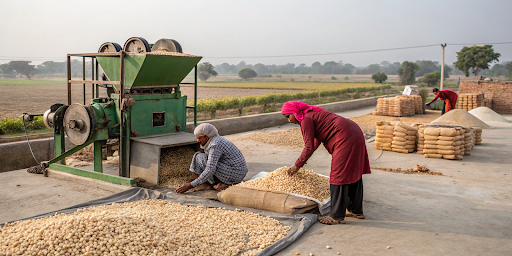Makhana Processing Units in Bihar: Transforming the Backbone of India’s Superfood Supply

The Bihar makhana industry has evolved from fragmented farms and age-old practices to a thriving sector supported by advanced makhana production infrastructure in Bihar. A core component of this transformation is the rise of makhana processing units in Bihar. These units handle everything from primary processing to packaging, enabling higher quality standards and wider reach into both domestic and global markets.
Makhana Wholesale Price in Bihar, which is directly influenced by the operational efficiency and availability of modern processing systems in the region.
Overview of Makhana Production in Bihar
Bihar, India, particularly north Bihar, is the undisputed leader in makhana cultivation. Farmers from Purnia, Bihar, Madhubani, and Patna contribute a large share of India’s total makhana seed supply. Most farms are small, typically spread over hectares of fragmented land, often passed down through generations.
Key Region | Cultivation Area (hectares) | Annual Output (tons) | Dominant Practices |
Madhubani, Bihar | 4,500 | 1,800 | Traditional farming, local ponds |
South Bihar | 2,100 | 950 | Hybrid makhana seed usage |
North Bihar | 6,000 | 2,700 | High yield farms, cooperative models |
These areas are crucial in maintaining makhana cultivation flow and ensuring farmers get access to makhana processing units close to their farm.
The Need for Efficient Processing Units
Historically, makhana was processed using rudimentary, manual systems that limited its scalability. However, the emergence of modern local makhana processing centers has revolutionized the landscape. These units serve multiple purposes:
- Drying and curing of harvested grains
- Sorting and grading makhana seeds
- Roasting through popping units and roasting machines
- High-capacity packaging facilities for export compliance
In Bihar, the proximity of processing centers to farms is essential. It minimizes post-harvest loss and helps maintain the quality of raw makhana to roasted makhana conversion.
Types of Makhana Processing Units in Bihar
There are several forms of makhana factories in Bihar, each with specialized roles in the makhana manufacturing process:
- Primary Units – Handle cleaning, drying, and grading
- Roasting Units – Execute popping and enhance flavor
- Packaging Units – Focus on hygienic, food-grade wrapping
- Integrated Clusters – All-in-one solutions for small-scale makhana processing units
These units have become the backbone of the makhana sector, boosting processors, farm families, and makhana growers.
Developmental Support and Infrastructure
The Bihar Govt, with institutions like BAU, Sabour, and Shastri Agriculture College, is actively promoting makhana processing industries through:
- Vikash Yojana grants under PMEGP/PMFME/Makhana schemes
- Modernized makhana manufacturing equipment
- Quality standards for phool makhana processing
- Training programs for makhana producers and processors
Notably, Bhola Paswan Shastri agricultural initiatives have supported multiple districts in adopting automated makhana processing.
Factors Affecting Makhana Wholesale Price in Bihar
The efficiency of makhana processing units in Bihar significantly influences the Makhana Wholesale Price in Bihar. Here’s how:
- Higher Processing Capacity → Greater volume of sale → Reduced operational costs
- Improved Quality Control → Better market trust → Higher unit pricing
- Quick Turnaround Time → Fresher product in market → Better margins
- Packaging Standards → Compliance with export norms → Premium international pricing
Impact of Processing on Makhana Price:
- Traditional Manual Processing:
- Output: ~8–10 kg/day
- Loss rate: 20–30%
- Avg. price: ₹400–₹450 per kg
- Semi-Automated Units:
- Output: ~50–60 kg/day
- Loss rate: <10%
- Avg. price: ₹500–₹600 per kg
- Fully Automated Processing:
- Output: 150+ kg/day
- Loss rate: <5%
- Avg. price: ₹650–₹800 per kg
Case Studies from Bihar’s Processing Belt
Kumar’s Journey in Patna
Kumar, a second-generation farmer from Patna, upgraded from manual makhana processing to a semi-automated popping unit through PMEGP funding. His profits rose by 40%, and he now sells to makhana companies in West Bengal and Delhi.
Madhubani Innovation Hub
A cluster of makhana producers in Madhubani, Bihar collaborated to create a small makhana factory that handles over 5 tons/month. By integrating sorting, curing, roasting, and packaging, the group accesses better makhana export contracts and earns 15–20% more.
The Role of Machinery and Modern Tools
The transformation of makhana processing would not be possible without state-of-the-art machinery:
- Roasting Equipment with uniform temperature control
- Grain sorting machines for seed-size consistency
- Automated drying chambers to reduce humidity impact
- Vacuum packagers to maintain shelf life of makhana snacks
These machines drastically reduce manual effort and allow bulk supply capabilities.
Export Potential and Global Reach
As makhana worldwide becomes more mainstream, makhana export processing in Bihar plays a critical role. Enhanced makhana units with food-grade certifications are now shipping to:
- USA
- UK
- Gulf Nations
- Japan
Exporters from bihar, india are tapping into the growing demand for:
- Organic makhana
- Popped makhana with flavors (salted, spicy, cheese)
- Makhana snacks in mixed nut packs
These products originate from processing hubs with modern makhana packaging facilities.
Challenges Faced by Processing Units
Despite success, the sector has hurdles:
- Unit space shortage for new entrants
- High initial costs for automated machines
- Difficulty in sourcing consistent makhana seed varies
- Poor cold storage infrastructure in south Bihar and states of Bihar
Solutions involve:
- PPP models with agriculture industry players
- Increased access to low-interest loans
- Strengthening cluster approach development in north Bihar
Market Forecast: 2025 and Beyond
With continued support from bihar govt, the next 3–5 years are projected to see:
- A 25% increase in small-scale makhana units
- Greater adoption of industrial makhana processing models
- Expansion in makhana price premiums through quality branding
Investments in this sector are expected to yield strong ROI, especially as makhana snacks continue gaining popularity in global wellness markets.
Conclusion
The rise of makhana processing units in Bihar has transformed how this agricultural industry operates. From traditional drying in open air to food-grade, packaged roasted makhana, the evolution is nothing short of revolutionary.
By improving quality, enhancing scalability, and ensuring Bihar makhana reaches every corner of the globe, these processing units are the hidden engines driving the Makhana Wholesale Price in Bihar.
